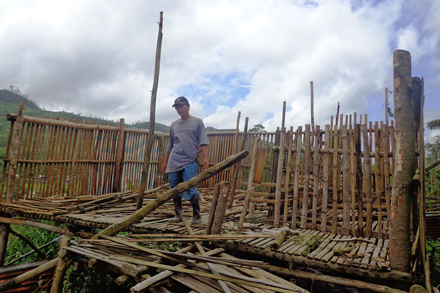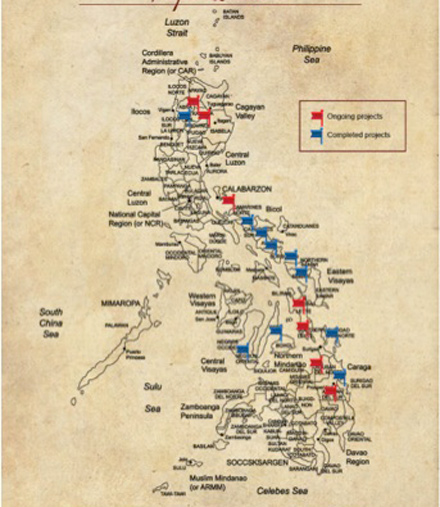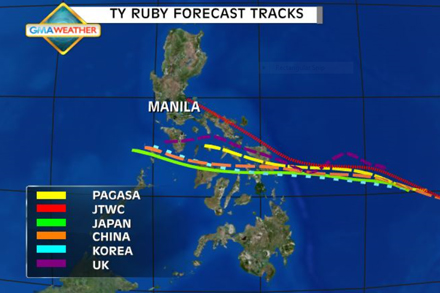UPDATE: FRIDAY, DEC. 12—Preliminary impact reports from project sites in the central Philippines indicate that Typhoon Hagupit was mainly responsible for damage to homes, animal shelthers and forage crops, Heifer International staff said Friday.
The heaviest damage was to the projects in the Ormoc area. Of the 300 project participant homes there, 280 sustained damage while 20 were destroyed. Another 260 animal sheds were damaged while 40 were destoryed. The Ormoc project lost seven goats, and between 80 and 90 percent of crops. Though there was no damage to infrastructure in Calubian, project participants lost seven goats and two sows to the storm.
All told, the initial assessments put the cost of the damage around $110,000.
"The best news is that there were no injuries to staff, partners or participants," said Noel Mace, Asia program manager at Heifer headquarters. "They used their Community Managed Disaster Risk Reduction plans as they should."
The Philippine government, along with relief organizations are meeting the immediate needs of food, clothing and medicines of people in the area, Mace said.
Heifer will continue to assess the needs of our project participants and will focus our efforts on their long-term rehabilitation.
-----
UPDATE: TUESDAY, DEC. 9—All Heifer project families are safe after Typhoon Hagupit, but many have reported damage to homes, animal sheds and crops, Heifer Philippines staff said Tuesday.

Program Officer Nieva Sambas said the farming families she spoke to Tuesday experienced heavy rains and strong winds for almost 24 hours as the typhoon passed over the central region of the island nation this weekend.
"The good news is all project participants are safe, and as they said, they are more prepared now," Sambas said.
Heifer Philippines made broad preparations for the typhoon, called Ruby locally, ensuring that all staff and partners were aware of the incoming storm so that they could implement their Community Managed Disaster Risk Reduction training (CMDRR). They moved animals and family to identified shelters and prepared food for at least three days, fodder and medicine.
Three large Heifer projects were in the path of the storm. Heifer Philippines has been working with farmers since 1954 and has 17 projects throughout the Philippines. The three projects support about 9,400 families.
Despite the preparations, the storm did cause damage.
Sambas said initial assessments indicate a few farming families lost their homes to the typhoon and many others sustained at least partial damage. Seven goats were killed, and three-quarters of project particpants said their animal sheds were either damaged or destroyed. Most lost animal feed.
While Heifer is not a relief organization, we supplement the work of relief organizations to help our farmers recover and then shift to long-term solutions so our participants can be better equipped to handle disasters. Help our farmers in their recovery efforts.
-----
UPDATE: MONDAY, DEC. 8—Heifer staff in the field are all safe and reporting no significant damage to their respective areas after Typhoon Hagupit, Heifer headquarters said Sunday night.
In an email to Heifer early Monday morning local time, Heifer Philippines Country Director Herc Paradiang said field staff had contacted the Manila office via satellite phones and confirmed the reports that the typhoon caused less damage than had been feared.
"They reported that as soon as it is safe to travel, they will be visiting project areas to know partner families' situations," Paradiang said.
The typhoon forced nearly 900,000 to evacuate, including Heifer farmers. The storm also has been blamed for more than 20 deaths so far. Updates about our projects and farming families will be made available as soon as possible. You can help our farmers recover here.
-----
UPDATE: SUNDAY, DEC. 7—Typhoon Hagupit made landfall in the Philippines Sunday morning, and while the extent of the damage to Heifer project areas is still unknown, preliminary reports indicate damage is less severe than last year's typhoon Haiyan.
Hagupit came ashore in the town of Dolores in Eastern Samar in the central Philippines with windspeeds of about 105 mph. All Heifer staff are safe and are still reporting strong winds, rain and power outages, said Noel Mace, Asia program manager at Heifer headquarters.

The damage to Heifer projects was not yet known.
"It will still take time to know what the damage is. It definitely seems as if the disaster preparation was well done and effective," Mace said.
Heifer Philippines made broad preparations for the typhoon, called Ruby locally, ensuring that all staff and partners were aware of the incoming storm so that they can begin implementing their Community Managed Disaster Risk Reduction training (CMDRR). They prepared food good for at least three days, and Heifer farming families moved animals and family to identified shelters and prepared food, fodder and medicine. Heifer was also coordinating with other NGOs to prepare response and support following the impact.
Three large Heifer projects are in the path of the storm. Heifer Philippines has been working with farmers since 1954 and has 17 projects throughout the Philippines. Seven of the projects are ongoing while 10 are in a reporting phase. The three projects support about 9,400 families.
Some news agencies are reporting about a one-foot storm surge, toppled trees and power lines and damage to some homes from the winds. Heifer headquarters remains in close contact with staff in the field and will continute to update as news from our projects sites is delivered.
Though Heifer is not a relief organization, as soon as we know the extent of the damage to our projects, we will supplement the work of relief organizations to help our farmers recover. Please help our farmers.
-----
UPDATE: SATURDAY, DEC. 6—Typhoon Hagupit's progress toward the Philippines has slowed, pushing back the time of landfall to early Sunday morning local time.
Heifer Philippines has made broad preparations in the last few days for the typhoon, called Ruby locally, ensuring that all staff and partners are aware of the incoming storm so that they can begin implementing their Community Managed Disaster Risk Reduction training (CMDRR), Heifer's Asia staff said.
"It's intensity has weakened. However, it is still expected to bring significant damage in a wider coverage from the areas hit last year by Haiyan (Eastern Visayas), including that of the Bicol Region," said Noel Mace, Asia programs manager at Heifer headquarters.
Wind speeds had fallen to about 115 mph Saturday, down from around 145-150 mph.
"The Central Region staff report that the weather in their respective areas is still normal except for intermittent rains," Mace said. "They have prepared for their safety, including food good for at least three days. Project sites have also done their preparation based on CMDRR."
Three large Heifer projects are in the path of the storm. Heifer Philippines has been working with farmers since 1954 and has 17 projects throughout the Philippines. Seven of the projects are ongoing while 10 are in a reporting phase.
Heifer farming families have moved animals and family to identified shelters and have prepared food, fodder and medicine, Mace said Friday. Heifer is coordinating with other NGOs to prepare response and support following the impact.
Heifer Philippines staff are also implementing their own threat response plans and are preparing to travel to the project areas after the storm has passed, Mace said.
We hope to have more information later this evening as the storm makes landfall.
-----
UPDATE: FRIDAY, DEC. 5—Heifer Philippines is readying for Typhoon Hagupit, or Ruby as it is called locally, ensuring that all staff and partners are aware of the incoming storm so that they can begin implementing their Community Managed Disaster Risk Reduction training, Heifer's Asia staff said Friday.

The typhoon's progress toward the island nation has slowed, pushing back anticipated landfall to Saturday night local time (early morning for the United States). Hagupit has also been downgraded from a category 5 storm to a category 4. While that gives staff and project participants more time to prepare, it also means Hagupit has "more time to grow in strength over the open ocean and that landfall might be prolonged," said Noel Mace, program manager for the Asia programs at Heifer headquarters.
Three large Heifer projects are in the path of the storm. Heifer Philippines has been working with farmers since 1954 and has 17 projects throughout the Philippines. Seven of the projects are ongoing while 10 are in a reporting phase.
Heifer farming families are "moving animals and family to identified shelters and preparing food, fodder and medicine as well as communication plans," Mace said. The work is being done in coordination with local disaster committees and other government entities, he said.
"We are coordinating with other NGOs to prepare response and support following the impact. Our three program staff in the path have satellite phones and the central Manila office will serve as the communications center," Mace said.
Different forecasting agencies are predicting various paths for the storm, but Heifer Philippines is expecting the storm to make landfall in Eastern Samar-Northern Samar in the central region of the island nation. They are prepping for strong winds, storm surge and heavy to intense rainfall.
Heifer Philippines staff are also implementing their own threat response plans and are preparing to travel to the project areas after the storm has passed, Mace said. Regional staff are reporting that schools have closed in anticipation of the storm, and that evacuation centers have been identified and readied.
Hagupit was packing sustained winds of 121 mph and gusts of up to 145 mph at its center.
In December 2012, typhoon Bopha wiped out the homes of 400 families involved in Heifer projects. More than 250 pigs and 90 goats died in the storm, and farming families saw more than 1,000 acres of rice, corn and banana lands ruined.
In November of last year, Super Typhoon Haiyan caused widespread damage to the Central Philippines, including to 1,250 Heifer project families. Many are still in the process of rebuilding from that storm.
-----
THURSDAY, DEC. 4: Heifer Philippines is preparing for Typhoon Hagupit, local name Ruby, which is expected to hit the island country Saturday. The storm is currently predicted to make landfall on Eastern Visayas and may affect areas devastated by last year’s Super Typhoon Haiyan.
Typhoon Hagupit had intensified and was already packing maximum sustained winds of 121 mph and gusts of up to 145 mph. As of 10 a.m. Thursday, the center of Hagiput was located 535 miles east of Surigao City. Hagiput had already become very dangerous and destructive, according to the Philippines weather service, PAGASA.
Heifer staff in the area is reporting rainfall and have been advised by the local government to evacuate beginning Friday morning local time. Heifer Philippines remain in close communication with field staff in the area, and Heifer headquarters in Little Rock are also in communication with our staff in Manila.
Three large Heifer projects are in the path of the super storm. Heifer Philippines has been working with farmers since 1954 and has 17 projects throughout the Philippines. Seven of the projects are ongoing while 10 are in a reporting phase.
The Philippines National Disaster Risk Reduction and Management Council and PAGASA had declared 44 provinces critical areas Thursday morning. These provinces are expected to experience heavy to intense rains, and strong winds from 60 to 70 mph. These provinces include the areas where Heifer projects have suffered losses from the previous Typhoons in both 2012 and 2013.
In December 2012, typhoon Bopha wiped out the homes of 400 families involved in Heifer projects. More than 250 pigs and 90 goats died in the storm, and farming families saw more than 1,000 acres of rice, corn and banana lands ruined.
In November of last year, Super Typhoon Haiyan caused widespread damage to the Central Philippines, including to 1,250 Heifer project families. Many are still in the process of rebuilding from that storm.
Heifer International is committed to supporting robust and sustainable communities in areas where we serve. In the event of a natural disaster, we implement longer-term rehabilitation and restoration of livestock and agricultural systems.
